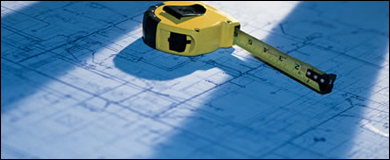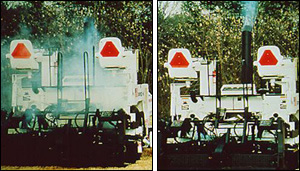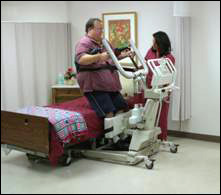Preventing Work-related Hazards through Design
 The Prevention through Design national initiative advances preventing or reducing occupational exposures, illnesses, injuries, and fatalities through the inclusion of prevention principles into all designs that impact workers.
The Prevention through Design national initiative advances preventing or reducing occupational exposures, illnesses, injuries, and fatalities through the inclusion of prevention principles into all designs that impact workers.

Before and after photos of design improvements to remove asphalt fumes from the vicinity of workers via engineering controls.
One of the best ways to reduce and prevent workplace injuries, illnesses, and fatalities is to "design out" or minimize hazards and risks. The National Institute for Occupational Safety and Health (NIOSH) is leading a national initiative called Prevention through Design (PtD) that embraces the "design out" concept. The PtD initiative addresses occupational safety and health needs by eliminating hazards and controlling risks to workers"; at the source"; or as early as possible in the life cycle of items or workplaces. PtD principles are applied to the design of work premises, tools, equipment, machinery and work methods including their construction, manufacture, use, maintenance and ultimate disposal or re-use.
Many US companies support PtD concepts because they have witnessed first hand the business value of PtD. NIOSH serves as a catalyst to make PtD "business as usual" in the 21st century.
PtD Interventions and Inventions
An article in an issue of NIOSH’s PtD newsletter, PtD in Motion, documents one innovative design to reduce hazards in the construction industry:
- Removing lead paint from bridges requires extensive measures to protect the environment and workers. A robotic bridge paint remover (RBPR) was tested at a pre-fabrication plant. The RBPR design removes the laborer from exposure to lead, while also drastically speeding up the operation. (See PtD in Motion, issue 2 for more details.)
PtD addresses occupational safety and health needs in the design process to prevent or minimize the work-related hazards and risks associated with the construction, manufacture, use, maintenance, and disposal of facilities, materials, and equipment.
Other PtD examples:
- The mechanical engineering curriculum at the University of Utah includes modules relating to safety, ergonomics, and health that can be easily incorporated into the undergraduate mechanical engineering curriculum.
- A prototype of a wheeled nail gun carrier developed and tested on construction sites to address the potential for back injury.
- A successful partnership effort led by The National Asphalt Pavement Association (NAPA) to remove asphalt fumes from the vicinity of workers via engineering controls. (See before and after photos, above.)
- User-based design: A case study in prevention of occupational exposure to blood.
- The creation of "Simple Solutions: Ergonomics for Construction Workers," a NIOSH publication intended to aid in the prevention of common job injuries that can occur in the construction industry.
Construction employs 7% of US workers, but disproportionately accounts for 21% of work-related fatalities—the largest number of fatalities reported for any of the industry sectors.
Full articles on each of these examples can be found in the PtD in Motion newsletters.
The framework for the PtD initiative was developed through stakeholder input at the first Prevention through Design Workshop, held in July, 2007. Representing all eight National Occupational Research Agenda (NORA) industry sector groups, the stakeholders offered their assessment of the needs, challenges and opportunities for the PtD initiative.
Their input has been used to develop a strategic plan highlighting actions and milestones to institutionalize the PtD concept throughout the United States. The workshop proceedings, including plenary session papers, break-out session reports, and peer-reviewed papers, were published in a special Prevention through Design edition of the Journal of Safety Research. This special edition of the Journal is available to subscribers or can be viewed on the NIOSH website.

Example of patient lifting device to reduce worker risk of strains and sprains as well as improve patient comfort and safety during transfers.
Partners in PtD
Organizations and companies that are NIOSH Partners in PtD include:
- The American Industrial Hygiene Association (AIHA)
- The American Society of Safety Engineers (ASSE)
- Association of Equipment Manufacturers
- The Center to Protect Workers’ Rights
- Kaiser Permanente
- Liberty Mutual
- The National Safety Council (NSC)
- The Occupational Safety and Health Administration
- ORC Worldwide
- The Regenstrief Center for Healthcare Engineering for the development of a
National Initiative on Prevention through Design


